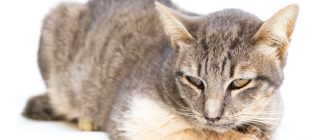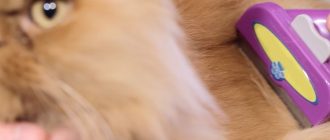Panleukopenia, better known among the people as the cat’s plague (plague) – contagious disease caused by parvovirus Feline Panleukopenia. The virus is highly contagious (extremely contagious viral infection), however, it is dangerous only for cats – people and others animals do not respond to the causative agent of the disease. The disease strikes gastrointestinal tract of the cat, cardiovascular and respiratory systems and bone marrow. Panleukopenia causes irreparable harm cat’s health by lowering white blood cell count, causing dehydration and intoxication of the body. Often the course of the disease complicated by secondary infections that make it difficult already severe condition of the animal, frequent and fatal outcomes (up to 90% in kittens and about 60% in adults). Most common disease affects young cats (up to a year), elderly and immunocompromised system. Healthy cats, full of strength, can also get feline plague.
Causes of Panleukopenia in Cats
Contents
The virus causing the disease is resistant to heat (up to 60 degrees), it is extremely widespread in the environment and can exist up to 1 years, found in urine, feces, saliva and nasal mucus of patients cats. Infection occurs by contact (when a healthy animal communicates with infected or newly ill) and airborne – drip ways, in utero (from mother to kittens). Often the master cats, without knowing it, becomes a carrier of the virus, to for example, bringing it to the house on clothes or shoes without washing your hands after communication with an infected animal. Intermediate hosts of the virus there are also external parasites – fleas.
Symptoms of cat plague
The incubation period when the virus has already entered the animal’s body, but the first precursors of the disease did not appear, ranged from 2 to 10 days. Further, the disease can take one of three possible forms: light, sharp or super sharp. The mild form is most often found in strong cats, with a strong immune system. Such a course of the disease involves the duration of the disease from 1 week to 1 month, the symptoms are erased, and only an experienced can confirm the disease Veterinarian and animal blood test. For light flow diseases are characteristic:
- Apathy, lethargy;
- Lack of appetite;
- Sometimes diarrhea and vomiting, but the animal does not look exhausted and overly weakened.
The acute form (lasting from 1 day to 10 days) is characterized by pronounced symptoms of ill health, the animal experiences suffering that is clearly visible to the owner’s view:
- Lack of appetite;
- Dehydration (the cat is thirsty, but cannot because of the violation digestive system);
- Diarrhea (fetid stool, sometimes with particles of blood, mucus);
- Vomiting (green or yellow, mixed with blood);
- Discharge from the eyes, nose (while eyes are sore, cat’s nose dry, crusty);
- Increase in body temperature (over 40 degrees), fever;
- Cramps
- Painful appearance: exhaustion, disheveled coat, lack of coordination, apathy;
- Wheezing, coughing, shortness of breath (if a complication struck upper respiratory tract);
- Rapid heartbeat, cyanotic color of the oral mucosa cavities (with damage to the heart).
The super-acute form of the disease is especially dangerous for young animals and old, weakened individuals – they are the ones who suffer first in this form. If untreated (and sometimes even in cases when it is provided) the animal most often dies during the day. Often a disease occurring in this form is so rapid, that the owner does not observe even part of those symptoms which are inherent in the acute form: vomiting, diarrhea, temperature, etc.
Diagnosis of panleukopenia in cats
After asking the owner about the alarming symptoms, the limitation of their appearance, the animal’s lifestyle, the veterinarian will prescribe tests: blood (for white blood cell count), feces (1-3 days after the start the disease is the most common virus), nasal examination cat’s secret. In addition to these actions, an experienced doctor, rather In total, he will find out cat plague visually.
Treatment for plague in cats
- Panleukopenia treatment involves the restoration of water balance of the body (fight against dehydration and intoxication), cat sodium chloride, Ringer’s solution or other drugs are administered;
- The introduction of etiotropic drugs that weaken and eliminate the effect of the virus;
- The introduction of antibiotics and immunomodulators to combat secondary infection and body support;
- Treatment with symptomatic drugs, depending on complications that are observed in a cat (rhinitis, conjunctivitis, gastrointestinal upset, etc.);
- The introduction of vitamins to replenish the lost strength of the animal and health improvement.
At the time of treatment, the cat should be isolated from other healthy individuals, the owner must take care of her peace: the patient’s bed the animal should be located in a darkened warm place, along The possibilities are also quiet. Mandatory disinfection procedures premises, airing. The animal should not be force-fed – during during such a difficult treatment, no cat will show appetite. Subsequently, you need to feed the cat often, but little by little – boiled beef, chicken (cut into pieces), cottage cheese. Never you should treat the cat yourself, as it will be missed precious time for medication. Popular among the people recipe for plague – vodka and raw egg. This mixture will result in irreparable consequences, because the cat is already suffering from disorders of stool, vomiting, bowel spasms. Yes, and other folk recipes should also not be used.
Cat Plague Prevention
The most effective method to combat panleukopenia is timely vaccination, helping to acquire a strong immunity to dangerous virus: at 8, 9, 48 weeks and then annually. To the owner it’s advisable to bring the cat to routine inspection to the veterinarian for timely detection diseases, as well as independently capture the signals of ill health and sound the alarm. It should increase the immunity of the animal, keep it in clean, feed quality food, and comply with prescriptions a doctor and not try to treat complex diseases at home unsuitable drugs. Panleukopenia – a disease with the highest the percentage of mortality among cats, therefore requiring timely treatment.






